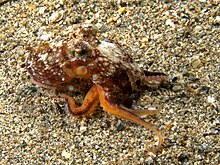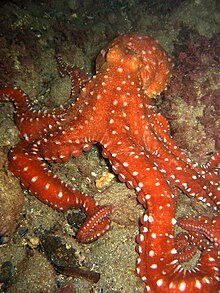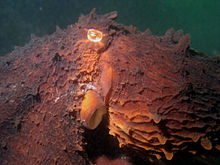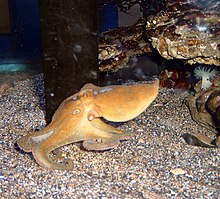Real octopuses
| Real octopuses | ||||||||||||
|---|---|---|---|---|---|---|---|---|---|---|---|---|

Pinnoctopus cordiformis , taken off the coast of New Zealand |
||||||||||||
| Systematics | ||||||||||||
|
||||||||||||
| Scientific name | ||||||||||||
| Octopodidae | ||||||||||||
| d'Orbigny , 1839 |
The real octopuses (Octopodidae) are mollusks and, with over 40 genera, form the largest family in the octopus order . The namesake genus of the family is octopus , which is also the largest with more than 80 species .
etymology
In technical language, octopus is always a masculine : the octopus . The octopus is only used in everyday language .
The term octopus was adopted from Danish - Norwegian into German and could stand for "uprooted tree", as the animals' arms protrude in all directions like roots. Duden specifies dialect Norwegian as the source language; the further origin of norwegian krake or kraken is unclear according to the Duden.
features
anatomy

anatomy
Real octopuses differ from one another between gelatinous, fleshy or muscular species, although the nature of the body mass is not specific to the species. The body of the real octopus is divided into mantle , head and tentacles, with the total length reaching from the tentacle tips to the rearmost end of the mantle. The coat length describes the length from the rear end of the coat to the eyes, which are usually in the middle of the head. Arm length includes the length of the tentacles from the end of the head to the tips of the tentacles. Size and body proportions vary between species. The largest known species is the Pacific giant octopus ( Enteroctopus dofleini ) from the genus Enteroctopus with an arm length of five meters. The smallest known species is the pygmy octopus ( Octopus wolfi ) from the genus of the octopus . This is only ten centimeters tall.
An important difference to other cephalopods is the complete regression of the Schulp or Gladius inner back shell. Octopodidae therefore do not have an internal skeleton and are therefore highly flexible; they can squeeze through the narrowest openings, they can make themselves as narrow as the distance between their eyes.
tentacle
In contrast to other cephalopods - such as squids and dwarf squids - real octopuses have eight instead of ten arms. The relative length of the tentacles is different in the individual species; it can vary from twice the length of the jacket to ten times the length of the jacket. The inside of the tentacles are covered with suction cups; their number varies with the individual species. In contrast to other cephalopods such as squids, the suction cup rings are built seated and radial and do not have barbs or teeth.
In males, one of the arms transforms into a hectocotylus . This special tentacle is used to transfer sperm in real octopuses. In most species, the hectocotylus has fewer suckers than in the other tentacles. Most real octopuses have a connecting structure called a ligula at the tip of the hectocotyledon arm . This is inserted into the fallopian tube of the female during mating and transfers the spermatophores to the female.
skin
The skin consists of a single-layer upper skin ( epidermis ) with embedded glands and a strafffaserigen, in some species but gelatinous leather skin (cutis). Many species are covered with wart-like structures. These so-called papillae can reach different sizes. In most species, the papillae have grown the densest around the eye region and are often the largest. The bottom layer of skin consists of reflective cells called leucophores. These consist of transparent, reflective proteins . The cells are able to reflect all wavelengths of light.
Body organs
Real octopuses have a multi-part heart with a main heart and two gill hearts. They have internal body cavities called coelomes . These fluid-filled cavities are of mesodermal origin and are lined with an epithelium . Octopodidae have two Coelome: The Viscero- pericardium -Coelom (body organs and heart) and the Nephridial-Coelom .
Octopodidae have very powerful lens eyes, which, in contrast to those of vertebrates, are eversely structured. This means that the light-absorbing layer of the photoreceptor cells faces the light. The eyes are the primary sensory organs and are usually large. But there are also small-eyed species. The eyes are usually one on each side of the head. Some species have stalk eyes or telescopic eyes. Real octopuses have a rectangular pupil that captures the light that is reflected from the ocean floor.
Real octopuses have a funnel organ ( funnel , siphon ; English: funnel ). This tubular organ is used for breathing and locomotion: You can use it to drive water out of the mantle cavity in jerks and thus move quickly forwards or backwards by recoil. In addition, the organ serves to intermittently discharge ink from the ink bag and waste products. The funnel is supported by muscles lying on the side.
Mouthparts
Instead of a set of teeth, real octopuses have a radula . This toothed mouth tool , which is also called the rasp tongue (or rasp tongue ), is very well developed in them. The radula is used to hold, grind and chop food. Most species have an advanced "lard tongue". This type of radula consists of a central tooth, called a rachis , side teeth, a central plate on both sides and side plates made of chitin. The rachis can have several tips. There are additional teeth below the radula and in the back of the throat. In addition, many species have a narrowing of the intestinal tract above the radula by lateral lobes, which in the squid are covered with a toothed chitin layer and are supposed to prevent the prey from sliding back.
intelligence
The octopus nervous system is highly organized and efficient, as well as being highly centralized. Real octopuses are very intelligent animals. Experiments with different species have shown that they can solve even complex tasks. Among other things, they are able to open jars with screw caps or other mechanisms and can assess whether they will fit through by scanning an opening. Octopodidae can also learn different skills through mutual observation. Some species mimic the appearance of other animals. In tests, the real octopuses were even able to imitate complex color patterns that do not occur in nature.
camouflage
Many species can change color and imitate other living beings and things. Although real octopuses are typically color-blind, they usually show a remarkable match with the color and texture of the background. This camouflage results from a combination of the reaction of different chromatophores and a change in the texture of the skin. The lowest layer of skin consists of reflective cells called leucophores. These consist of transparent, reflective proteins . The cells are able to reflect all wavelengths of light. There are also iridophores. These are cells with a content of thin chitin flakes . They shimmer in blue, green and silvery hues and work like an interference filter . The extent to which the iridophores increase the brightness has not yet been clarified. In addition to the rapid color change, Octopodidae can change their skin surface from smooth to coarse black and thus adapt to the subsurface.
Poison
Except for the species of the genus Hapalochlaena , real octopuses have only a very weak poison that is insignificant for humans. The former, however, have a strong poison which they release when bitten and which can also be fatal for humans. It is a neurotoxin , tetrodotoxin (TTX), which is also known under the name maculotoxin or tarichatoxin, which some other animals also have, such as puffer fish and snails . However, the producers of this poison are not the octopus themselves, but bacteria that live in the foregut and the salivary glands of the octopus and that are passed on to their offspring.
Reproduction
Mating takes place when the males form sperm packages, so-called spermatophores . These are transmitted to the female with a special tentacle, the hectocotylus . The spermatophores lie along an open depression on the Hectocotylus, which ends in a spoon-shaped tip, the ligula . The male places the sperm packets directly into the female fallopian tube. The females of many genera can store the sperm in their bodies so that they can be fertilized for up to ten months. With some genera it also happens that the females mate before they reach sexual maturity and carry the sperm of the male until they have become receptive. In many species of Octopodidae, the females stay with their eggs during the breeding season and completely stop eating. After the young have hatched, the female dies.
Females are more common than males in most species.
distribution
The different genera of the Octopodidae can be found in all oceans and in all climatic zones of the earth. They occupy a wide range of habitats, including rocky and coral reefs, seagrass beds and algae beds, sand, mud and other soft substrates. Most Octopodidae are basic inhabitants . Some shallow sea species can also survive and move outside the water for a period of time. Specimens often go to tide pools to hunt for crabs, snails and other animals. However, because, like all cephalopods , they breathe with gills , they cannot survive on land permanently. Genera of the Octopodidae have so far been detected at a depth of up to 5000 meters.
Systematics
The octopus family comprises more than 40 genera with well over 250 species. Some species are broken down into subspecies. However, many species are still undescribed and have not yet been considered here.
See also
Web links
Individual evidence
- ^ World Register of Marine Species
- ^ Catalog of Life
- ↑ a b Cf. Krake at Duden online
- ↑ See Wolfgang Pfeifer (Red.): Etymological Dictionary of German. Edited by the Central Institute for Linguistics, Berlin (East) 1989, p. 921
- ↑ a b c d cephalopods , Siegfried H. Jaeckel (1957), A. Ziemsen Verlag, ISBN 3 89432 638 7
- ^ Cephalopods of the world. An annotated and illustrated catalog of cephalopod species known to date (p.22)
- ↑ a b c d e f g h i Octopodidae - Article at Tree of Life
- ↑ a b c d e Robert Nordsieck: Kraken (Octopodidae)
- ↑ a b A classification of the living Mollusca , Vaught, KC (1989), American Malacologists, ISBN 0-915826-22-4
- ↑ a b c d e Octopus skin as super reflectors
- ↑ a b Cephalopods of the world. An annotated and illustrated catalog of cephalopod species known to date (p.25)
- ↑ Urania Tierreich, Volume 1 Niedere Tiere , ISBN 3-332-00491-3 , pp. 575, 580
- ↑ a b Herder - Lexicon of Biology (2003)
- ↑ Gerhard Roth, How unique is a person? - The long evolution of the brains and the mind , Spektrum Akademischer Verlag ISBN 978-3-8274-2147-0 , pp. 105, 107, 110, 139 ff
- ↑ a b Becky L. Williams, Charles T. Hanifin, Edmund D. Brodie Jr., Roy L. Caldwell: Ontogeny of tetrodotoxin levels in blue-ringed octopuses: Maternal investment and apparent independent production in offspring of Hapalochlaena lunulata. In: Journal of Chemical Ecology. Volume 37, No. 1, 2011, pp. 10-17, doi : 10.1007 / s10886-010-9901-4















